Matador Network's Blog, page 2244
July 13, 2014
16 things people get wrong about DC

Photo: Elvert Barnet
FROM HOLLYWOOD to the news media, depictions and stereotypes of Washington, DC, always seem way off. The city isn’t remotely like House of Cards, it’s not as full of conniving and kinky sex as depicted, and where, for the love of God, in all of these movies, are the non-white people?
1. Everyone is sexy.
For obvious reasons, Hollywood usually depicts DC as full of Robert Redfords and Kate Maras and Gerard Butlers and Julia Robertses. This is because Hollywood is full of unemployed Kate Maras and Gerard Butlers and needs to give them something to do. DC is of average attractiveness, and you don’t need to be attractive to get into power. Look at Mitch McConnell.
A friend of mine once said, “DC is Hollywood for ugly people.”
2. Everyone is smart.
I know you’re thinking, “No one thinks that,” but seriously — we’d have to be a much smarter city to pull off all those conspiracies you think are being masterminded here.
3. Everyone is stupid.
If someone makes a “gaffe,” they aren’t necessarily stupid. If someone disagrees with you, they aren’t necessarily stupid. While DC is hardly a city filled to the brim with geniuses and prodigies, it’s still a pretty smart city. This country is just that hard to govern.
4. Everyone is incompetent.
Most bureaucrats actually tend to be pretty well-educated, well-qualified people. In regards to most politicians, do you realize how competent you have to be to get that little done and still hold onto your job? They might not be competent in the ways you want them to be, but most of them know exactly what they’re doing.
5. Congress is evil.
Congress is pretty representative of America. If they’re evil, it’s because you’re evil.
6. This is a rich city.
I have never met any of the so-called Washington “fat cats,” but that may be because I’m poor. Regardless, there are a lot of people like me here, and there are also a lot of people who are way poorer than me.
7. Everyone is greedy.
Congressional staffers, for the most part, are incredibly smart and well-educated and get shit pay. They do their job because they believe in their job. The city is also filled with really idealistic nonprofit workers and bureaucrats genuinely trying to make life better for people they don’t know.
8. People are just into real kinky sex here.
For whatever reason, every depiction of DC sex involves leather and a ball gag. I have yet to be at a friend’s party and then, while looking for the bathroom, stumble upon their sex dungeon.
9. This is a conservative city.
My lefty friends all think DC is a really conservative city. Really, the only conservatives here are the Republicans in Congress. The city overwhelmingly votes Democrat in every election, and while our mode of dress tends to be professional and conservative, we have the largest out-of-the-closet gay population in America, and we recently decriminalized pot.
10. This is a left-wing city.
My conservative friends and family members tend to look at DC as a modern-day Sodom. Which, given the whole gay thing, isn’t totally inaccurate, but honestly, it’s hardly a bastion of revolution. The entire city’s economy depends on establishment, so it’s not a super easy place to get a job if you’re an anti-establishment type. Yes, it’s traditionally liberal, but it’s not revolutionarily leftist.
11. Everyone is power-hungry.
Most of us are just hungry. It’s like, a 40-minute walk from me to the nearest Shake Shack, and I’ll be damned if I’m eating something other than Shake Shack.
12. The town’s a bubble that’s out of touch with the rest of America.
I’m not from DC. My fiancee’s not from DC. Literally none of my friends are from DC. It’s an incredibly transitory town, with a lot of people moving into the city from homes around the country to work for a while and then move back home. This isn’t everyone, obviously, but the idea that a city that has people from literally every place in America is out of touch is a bit ludicrous.
13. We don’t have good pizza.
We don’t have the best pizza. But after living in London and not touching a good pizza for over a year, I’ll take a slice from We the Pizza any day.
14. We’re gaudy.
The immensely rich are the most likely to be gaudy. And they don’t live in DC. You want to know why? Because they can hire people to do what they want to do in DC.
15. It’s violent.
Look, like every major city, DC has its crime. It also has a pretty serious race and class divide. But crime has been on the decrease here in DC for a few decades now.
16. It’s just a bunch of white Senators.
For whatever reason, in media depictions, the city seems to be made up solely older white men. Seriously guys — this city is almost 50% black, and about 10% of the city is of Hispanic descent. You’re not even trying anymore. 

July 12, 2014
Trippy night sky panoramas [vid]
The internet is flooded with timelapses of the night sky, but pretty much none of them look like this.
Vincent Brady used a multicamera, 360-degree rig to capture panoramic timelapse images of the night sky. His shoots — which ranged from the American Southwest to Glacier National Park to British Columbia to Missouri — are incredibly trippy, melding together images from several cameras and transposing a 360-degree view on a flat surface.
You can check out his explanation of the process of making the video on his YouTube page. The rig itself looks pretty rudimentary, with just four fisheye-lens-equipped cameras connected by a homemade cross. He’s also got more detailed notes on his webpage if you want to give this method a try yourself. 

Mapped: World Cup winning nations

THE 20TH FIFA WORLD CUP, the international men’s football tournament featuring 32 teams from all over the world who, for the past few weeks, have been sweating it out in the Brazilian sun and rain, ends tomorrow, July 13th, with the final match between Argentina and Germany.
The tournament has taken place every four years since 1930 (with the exceptions of 1942 and 1946). In the 19 previous competitions, although a total of 77 countries have participated at least once, only eight have won the championship. As you can see from the map above, there are two world regions that seem to have a stranglehold on the title — and, regardless of what happens tomorrow, that fact will not change.
Hover over the map to see how many times each country took home the cup and when, and let us know in the comments below who you think tomorrow’s big winner will be. 

July 11, 2014
9 signs you went to college in NYC

Photo: Jeffrey Zeldman
I left everything I knew back on the West Coast to live in New York City so I could follow a boy to college. Our relationship was over by the end of freshman year. As my five-year reunion approaches, and I interact with other grads, I can’t help but think of all the ways going to school in New York City was so completely different than attending college anywhere else. Here are the unifying factors.
1. You had no interest in school sports.
I went to homecoming my senior year mainly to find out where our football stadium fit within the tight grid of New York City. It was a 20-minute bus ride up into Harlem proper, and the stands were largely empty. Ashley, my most sports-inclined friend, took me to the parking lot to tailgate, where there were a few parked cars and a tent with a barbecue. We got drunk on foamy kegs of Bud Light, and I think someone put a temporary tattoo on my cheek. To this day, I still have no idea who won.
2. You went to that sketchy little head shop on the Lower East Side for a fake ID.
Underage clubbing in New York is like your parents smoking pot — no one really talks about it, but we all know it’s happening. Like some unspoken ritual, you took the subway downtown to the infamous head shop, anxiously strolling past rows of bongs to a closet-sized room. $85 cash for the standard. $150 if you wanted it to scan.
A few months and $150 later, you realized that every promoter, rapper, DJ, competitive bartender, or shaggy-haired drummer you might meet in Washington Square will offer to get you on “the list” — no ID required.
3. You accidentally went broke the first month, giving money to every homeless person and street performer on the subway.
After two weeks, you limited yourself to just that really awesome merengue band at Union Square or the tap-dancer kid at the Columbus Circle stop. Even then, you still ended up alternating between spending like the world was going to end — taxis everywhere, $20 rooftop manhattans, new restaurants every night — to living like the world had already ended — ramen noodles on the dorm-room floor, going to various campus events for free booze, hawking old textbooks at the Strand bookshop, and jumping through subway turnstiles.
4. You were freakishly attached to your corner bodega.
I met Amir that night when he delivered condoms and a pint of ice cream to my door. I didn’t need the condoms, just the ice cream, but wanted to know for certain I could get them.
My corner bodega, one of thousands of the ubiquitous 24/7 convenience stores you’ll find on each New York City block, was undoubtedly the best. The bagel, egg, and cheese breakfast sandwich that eased my hangovers each Sunday morning, the cashier who knew he’d see me for chips and a Snapple every Thursday at 2am, the dusty canned goods, all-hours delivery, and a limited fresh fruit selection — I’ll defend my bodega until the day I die. Amir, I got your back.
5. You pretended Times Square didn’t exist.
Exception to said rule: heading to TKTS on a free Monday afternoon to get half-priced, same-day tickets to a show. Or those periodic visits with friends or family who insisted they hadn’t seen the city until they’d been to Times Square. During those times, you’d text a friend, “Remind me to never come back here. I can’t move or breathe, the giant Bubba Gump Shrimp mascot won’t get out of my way, and I just pushed someone’s grandma into the street.”
6. You hooked up with someone from the cast of Gossip Girl, James Franco, Macaulay Culkin, or that girl who played Matilda.
Overheard on the train platform at the Lincoln Center/Juilliard stop:
“Dude, remember that movie Matilda?”
“Yeah.”
“I totally hooked up with that chick at a bar on St. Marks last night.”
“Nice.”
“I kind of wanted to ask her if she’s still friends with Danny DeVito.”
Whether it’s Matilda at a dive bar, Dan Humphrey (née Penn Badgley) eating grilled cheese around 4am at my neighborhood diner, James Franco reading poetry for his graduate seminar on the campus lawn, or Macaulay Culkin throwing a “Macaulay Culkin’s iPod” party at Le Poisson Rouge, actors are everywhere. They’re drinking your milkshakes, taking your classes, lurking at nightclubs, and making out with your ex.
7. You separated the city into school districts.
The Upper West Side was our territory: Columbia, Barnard, and Manhattan College of Music, though I’m not sure they moved about in daylight hours. Washington Square Park was a veritable congregation of Ginsberg-reading, hula-hooping NYU and New School kids. Uptown, a common weekend conversation included, “So, my NYU friend is having a party down by Wash Park. It’s actually right off the 1 train, I swear.” Lincoln Center was Julliard’s campus, but they never really stayed in one place. The area around FIT was a mecca for all your guy friends, due to a largely female, abnormally attractive population of undergrads.
Ultimately, it didn’t really matter. Post-graduation, we all moved to Brooklyn anyway.
8. Your dorms were the best deal on real estate you could (and will) ever have in NYC.
Yes, they varied. One year, you lived in a brownstone off Broadway, with central heating and air conditioning. The next year, you were in a square room off a linoleum-tiled hallway somewhere down Amsterdam Avenue (or deep into Chinatown — I’m looking at you, NYU kids). Despite this, you’d never think of trying to strike out on your own. That building next door, full of disgruntled families and 30-something lawyers? Paying double.
9. You were a smoker, a clubber, a hipster, a member of a street band, and a part-time lesbian by the time you were 19.
Going to college in New York City means certain “exposure” — to new places, peoples, cultures, lifestyles, and, yes, even the junk of that flasher guy Larry on the L train. You’ll likely start smoking, stop smoking, go to Meatpacking District nightclubs, decide nightclubs are the seventh circle of hell, go to dorm parties where you have to sign in to the building, become the harmonica-playing frontwoman of a riot grrrl folk band, experiment with your sexuality, hang out at drag shows, start a campus Bubble Tea and Victorian Literature club, go bowling, and order in bagels at midnight…and, oh yes, attend classes. 

The world's best music scenes [vid]
I’m ashamed to say that, as much time as I’ve spent playing geography games on Sporcle, I had never once heard of Gothenburg until watching this video.
Gothenburg is the second-largest city in Sweden, and it apparently has awesome music. I know about Gothenburg now because of the video series New Music Cities. This incredible series has covered New York, London, and Tokyo so far, and decided to jump to a much smaller, lesser-known city that, as it turns out, still has an amazing music scene.
The video takes you on a musical tour by speaking to a few bands about the city, its culture, and the music scene while their music plays. Kudos to New Music Cities for doing this, and here’s to hoping they eventually get around to every city on the planet. 

Reading makes you a better person
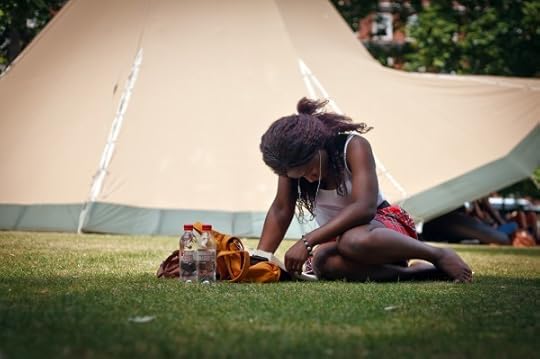
Photo: Lena Vasiljeva
“Books are much more. They are a way of being fully human.” — Susan Sontag
Anyone who’s ever cozied up in a corner with a fascinating novel knows the pleasures of an afternoon spent reading. Perhaps it was whizzing through breezy books like the Harry Potter series or spending time (and a great deal of energy) grappling with the more serious concepts put forth by the likes of Dostoevsky or Safran Foer. Either way, finding that truly engaging novel is a beautiful moment, always something to be cherished. As C.S. Lewis said, “You can never get a cup of tea large enough or a book long enough to suit me.”
But what if reading is more than just a simple pleasure, more than something that entertains and engrosses?
In a recent study from Emory University, researchers found that people who read stimulating novels experienced lasting neurological changes. The study only checked the participants’ brains up to five days after the test, but it appeared their brains had been permanently rewired. Fascinatingly, these changes were found mostly in the left temporal cortex, which is the area in charge of language receptivity. Neurons in this part of the brain have been known to create “grounded cognition,” which is when your brain tricks your body into doing something just based on thinking. For instance, if you’re thinking about eating, your mouth may begin to produce saliva with the expectation that it will soon be processing food. When reading, your brain can be tricked into thinking you, the reader, are genuinely part of the story, deeply connected with the protagonist and his/her plight.
As Gregory Berns, the head researcher of the study, wrote, “The neural changes that we found associated with physical sensation and movement systems suggest that reading a novel can transport you into the body of the protagonist.” He added, “We already knew that good stories can put you in someone else’s shoes in a figurative sense. Now we’re seeing that something may also be happening biologically.”
What’s happening is that readers are being made into more aware, more morally conscious people. In our day-to-day existence, we often only see one side of a person, oblivious to what’s really going on in their life or what could be driving their words and actions. Perhaps the seemingly weird, awkward classmate is, unbeknownst to her peers, helplessly watching her parents go through a divorce at home. Or maybe the attention-seeking narcissist at work has actually recently lost his brother, the only person who’d validated him and quelled his insecurities. When we read a novel, we get the whole picture; we see a character’s complete life. All the empathetic emotions we feel for characters in novels actually wire our brains to have the same sort of sensitivity towards people in the real world.
Neuroscience and sociology show that books really do make us better people, yet it’s important to never lose sight of the real meaning of reading.
The ability to realize that other people may have differing beliefs, desires, intents, and knowledge than oneself — what scientists and philosophers call “theory of mind” — is likewise enhanced by reading high-level fiction, according to a recent study in Science. Massive deficits of “theory of mind” can be found in people with autism, attention deficit hyperactivity disorder (ADHD), and schizophrenia, but, to a certain extent, everyone is somewhat deficient in this kind of empathy and understanding. We all tend to think mainly about ourselves and often forget that our priorities, our likes and dislikes, are not necessarily the priorities of everyone else. It’s through reading books that this can be best countenanced and changed.
Ironically, one might learn about the world, about how to be a more empathetic and understanding person towards others from reading; but, if one were to spend all his/her time reading, one would never even have a chance to commiserate, to socialize in a truly positive way. I had the pleasure of speaking with the author Jess Walter, and, in talking about literary ambitions, he noted how so many people misunderstand the amount of loneliness that’s required to be a writer.
The example he gave was of Ernest Hemingway. In the 1920s and ‘30s, many Americans who’d read about Hemingway’s experiences in the fantastic restaurants and bars of Paris set out to find him in the very locales he described. But, when they got there, they were invariably disappointed, for he was rarely in the places he was writing about. He was alone, usually in his apartment, working away. Same goes with reading. If one were to understand a vast variety of characters by diving into the literary greats and the modern classics — able to glean new information and attain unique perspectives — one would never actually have the time to use these newly learned viewpoints and understandings in the real world.
And thus, reading should never be looked at exclusively as a way to improve ourselves. Neuroscience and sociology show that books really do make us better people, yet it’s important to never lose sight of the real meaning of reading. As Gustave Flaubert said, “Do not read, as children do, to amuse yourself, or like the ambitious, for the purpose of instruction. No, read in order to live.” 
This post was originally published at Medium and is reprinted here with permission.

4 reasons train travel is the best

Photo: Ahmad Hashim
A FEW YEARS AGO, I bought a rail pass from Amtrak. For 15 days, I was allowed to ride on up to eight trains going pretty much anywhere in the United States. Since I was about to leave the country for a year of grad school, I decided to visit my friends on the West Coast, and then to loop back around to the East Coast to meet some other friends for a beach weekend.
I probably spent around five of those 15 days actually on the trains. Once, we got stuck in a field in Montana for 15 hours while we waited for the crews to switch. Once, a crazy lady sat down next to me and talked — whether I was listening or not — about how the NSA was beaming porn into her head while she was trying to go to sleep. Once, a caricature of a redneck sat down next to me and pulled out a photo album of his gun collection for me to peruse.
But I still loved that trip. Far more than I’ve ever enjoyed traveling on a plane or in a car, and almost as much as the cruise I took when I was 12 and got to binge on free pizza for seven days straight. The US hasn’t invested all that much in trains lately, favoring sitting in hours of traffic or flying on increasingly less comfortable planes. Here’s why American travelers should be riding the rails as much as possible.
1. There’s so much space.
Look, the reason airplanes are atrocious isn’t entirely the fault of the airlines. It’s a tough business to make a profit in, so naturally they’re going to try to cram as many people on the plane as possible. It doesn’t really serve them to make the planes more comfortable. But trains are absolutely delightful to travel on. First, the chairs are a little more spread out, and a little wider, so a 6’3″, 220lb gentlemen like myself can fit comfortably.
Second, because it’s so crammed on planes, it’s easy to feel like getting up and walking around is an inconvenience if you’re not sitting on the aisle, so instead you hang out in your tiny seat, eventually get deep vein thrombosis, and then you die. But trains have dining cars and some have viewing cars. You can go grab a cup of coffee and meet a friendly looking stranger. You can not die a horrible death on a long flight over international waters.
2. It takes way longer to get there by train.
I can see why you might think this is a bad thing. But here’s why it’s not: First, train travel is actually one of the more environmentally friendly ways to get around, especially if you’re traveling on your own or with just one other person.
Second, because it’s easy to move around on a train, this is actually a pretty nice way to spend your time. Most Amtrak trains have wifi now (though it can be spotty), and there are some amazing viewing cars that are especially spectacular if you’re going through the Rockies or the Midwest. There’s also generally a dining car and a snack bar, and the snack bar usually serves the type of mediocre coffee that’s perfect for sitting with at an empty table, reading a long book as the country zips by.
That’s actually my favorite part about trains. You can read, you can write, you can draw, you can catch up on TV shows (if you’ve got them downloaded or on DVD), and you can have leisurely conversations with your fellow passengers. I’ve actually made friends on trains, which has never happened on a plane for me. It’s hard to be friendly when everyone around you is miserable and counting the minutes till landing.
3. It’s really hard to hijack a train.
Okay, so this doesn’t happen that often on planes either, but seriously — if you were to hijack a train, you’d still have to go wherever the tracks lead. You’re not ever going to have a Malaysian Flight 370 situation with a train. Yes, it can crash, and yes, you could totally be killed while riding on a train. But you know what you don’t have to deal with?
Airport security. You don’t have to take your shoes off. You don’t have to get anally probed. You don’t have to explain why you have an inhaler to a particularly dickish TSA agent. You don’t have to worry about some creep looking at you naked with that new x-ray machine of theirs.
This has a few knock-on effects. First, it means you don’t have to get to the station two hours early. You can cut it relatively close. Second, it means you can bring your own water and food on board, which means there can actually be healthy, refreshing food options that don’t cost you half of your trip budget. And third, it means there’s a whole different group of people you get to ride with. Which brings us to…
4. The people who ride trains are way more interesting than the people who ride planes.
Each form of travel has its own constituency. Airplanes tend to be more business-oriented, as businessmen don’t have time to take long trips, and because they like having large, confined audiences to be awful in front of. Boats tend to be populated by vacationing suburbanites, working-class sailors, or people who think Jimmy Buffett’s lifestyle is something worth aspiring to.
Trains are ridden by people with quirks. Sometimes this means the lady who thinks the NSA is beaming porn into her head; other times it means the people who are afraid of flying. But usually it’s something much more innocuous and endearing. I’ve found that the type of people who take trains are people who aren’t as keen on getting to their destination as they are enjoying the journey, which is generally a much more interesting type of person.
There are also a lot of Amish that ride the trains, which is cool because it’s just not a part of America I’m remotely in touch with, even though apparently like 50% of the Amish in America share the same last name as me. Regardless, the people on trains are far less furious that they’re traveling, and as a result, are a far friendlier crowd than you’ll find on most other forms of travel. So take a train for your next trip. 

The 23 best drunk foods in America
WHEN FOOD WRITERS discuss food, they should divide it into two categories: sober food and drunk food. Sober food is what you eat when you go to a fancy restaurant and want real artisanship put into your food. It’s what you want to spend lots of money on eating. Drunk food is what you shove down your throat after a night of heavy drinking in the misguided hope that it’ll absorb whatever alcohol hasn’t yet made it into your blood stream.
As far as I’m concerned, one category isn’t better than the other. I love a well-prepared meal, but there’s something truly awesome about having a line cook slop grease onto a plate in front of me and then expect me to eat it, ashamed, in the alley next to the restaurant before catching a cab home.
Each of America’s regions has its specialties — pizza in Chicago and New York, Mexican in the Southwest, barbecue everywhere — but America is America, and we know how to seize on a good idea and then take credit for it ourselves. For drunk food, of course, distinctions like “who did it first” and “where it’s the best” don’t matter — all that matters is “is it in front of me?” and “can I keep it down?” Here are some of America’s best regional (and national) drunk foods, as well as a place or two to find them.
1. Chili dog

Photo: Jeffrey W
What could be simpler? A hot dog with chili con carne and cheese. Probably most famous on the East Coast (we’ll get to Cincinnati’s variation later), the chili dog (or “Coney”) is a classic drunk food. The best that I’ve had is at Ben’s Chili Bowl in DC.
2. New York pizza

Photo: Guian Bolisay
The eternal feud between the New York and Chicago schools of pizza is silly because the two are so fundamentally different. And they’re both delicious. It’s like an argument over who’s better, the Beatles or Stones? Answer: Who gives a shit? The world’s wonderful with both. Time Out gives the best slice of pie to Lucali, but the City’s got so much great pizza that who really cares about rankings?
3. The humble hamburger

Photo: Robyn Lee
Hamburgers are an American institution, but each region has its own best burger. The best fast food, non-gourmet, perfect-for-being-drunk burger I’ve had is from In-N-Out, which is the strongest argument I’ve got for moving to the West Coast. Honorable mentions to Shake Shack and Five Guys.
4. Tacos

Photo: Ulterior Epicure
My friends from out West complain that there’s no good Mexican here in DC, and while I disagree (what up, District Taco!) I know the true home of Mexican food in the United States is the American Southwest. The Daily Meal gives the “best in the country” distinction to La Taqueria in San Francisco, but honestly, as long as I’m trashed and can eat 17 of them, I’m good with whatever.
5. Garbage plate
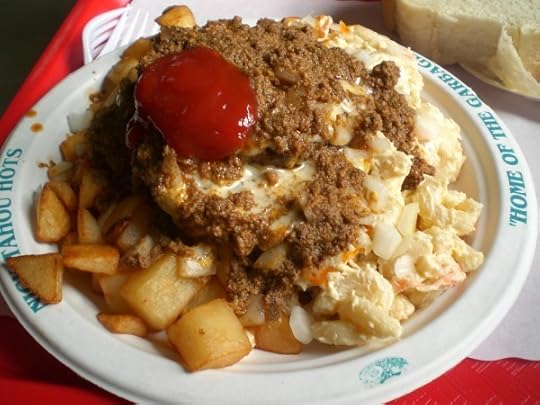
Photo: KNile
There is only one, and that is at Nick Tahou Hots in Rochester, New York. A garbage plate is exactly what it sounds like: a pile of greasy food. That includes cheeseburger, Italian sausage, red hots, chicken tenders, eggs, and a number of other things (depending on the variation you order). It’s like a fat sandwich (keep reading), but without the pretense of putting a bun on it. Time to go get drunk in Rochester.
6. Gyros
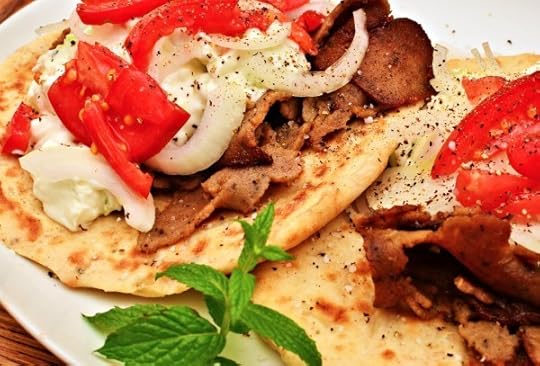
Photo: jeffreyw
Pronounced “yeer-ohs,” not “jy-ro,” the gyro is a traditional Greek dish of roasted lamb, some veggies, and tzatziki sauce wrapped in a pita. I feel like I stumble across gyros while wandering drunk through unfamiliar neighborhoods, and it’s always like bumping into an old friend. Try Bill’s Gyro Souvlaki in Atlantic City.
7. The McGangbang
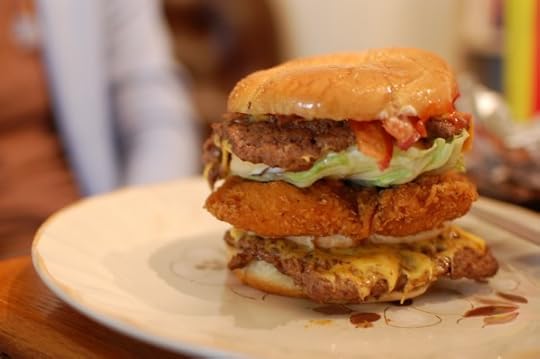
Photo: Jim Kelly
You’re probably going to get blank stares if you walk into McDonald’s and order the McGangbang. Here’s what you do instead: Get a double cheeseburger and a McChicken, then put the McChicken between the cheeseburger patties, and you’ll have made drunk food perfection. The one pictured above is actually made from Wendy’s burgers, but hey, you’re drunk, you can’t tell the difference. Available literally everywhere.
8. Nachos

Photo: AlanaGKelly
You’d think nachos would be harder to fuck up — chips with meat, cheese, maybe some veggies? But it’s weirdly hard to find really delicious nachos, especially if you aren’t living in the Southwest. You’ve got to layer the ingredients, guys! I don’t want to get to the bottom of the pile and just have corn chips!
9. The Kentucky hot brown

Photo: Tojosan
The Kentucky hot brown is a staple drunk food in the Bluegrass State. It’s an open-faced turkey bacon sandwich covered in Mornay sauce or, in a pinch, just molten cheese. I really don’t need to sell it any more than that. Try it at its home: the Brown Hotel in Louisville.
10. Philly cheesesteak

Photo: Jpellgen
My favorite thing about Philadelphia is the cheesesteaks. Jon Stewart, who’s been making a career of picking food fights with other cities, recently tried to do a takedown on cheesesteaks but admitted at the end of the bit that he actually loved them, even though you have to order them “with Whiz.” My favorite is pictured: Pat’s King of Steaks, home of the cheesesteak. I know people who would murder me for picking Pat’s over Geno’s, though.
11. Poutine

Photo: Jenny Potter
Let’s give credit where it’s due. This is a fundamentally Canadian (or, for the separatists, a fundamentally Quebecois) dish. But fries covered in gravy and cheese curds is an idea so beautiful that it belongs to everybody, especially the drunks. Americans are mercifully starting to steal this wonderful recipe and selling it to drunks on our streets, but for the best, Thrillist suggests Le Banquise in Montreal. Add steak to take it to a whole other level.
12. Chicago deep dish

Photo: Sara B.
I had to put pizza on here twice for its two most famous incarnations. Chicago deep dish is, as Jon Stewart put it, almost “a fucking casserole.” But God bless this casserole. It’s much more deserving of the title “pie” than its New York counterpart in terms of structure, and the good thing is you can fill it with ingredients, making it perfect for drinking. Thrillist gives the honor to Lou Malnati’s, but it’s an intense debate.
13. Burritos
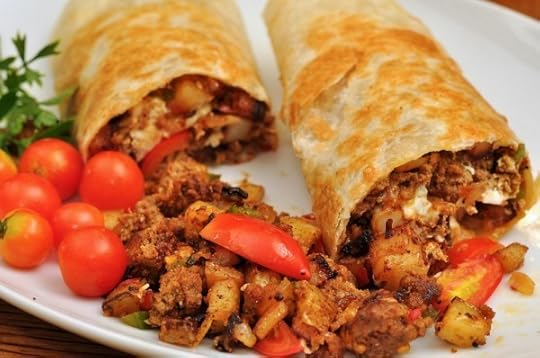
Photo: Jeffrey W
The true essence behind the best drunk food is “pile as much shit as possible together and wrap it in something.” That’s also the definition of a burrito, which directly translates to “little donkey.” Nate Silver, predictor of elections and seer of everything, is currently running a Best Burrito in America knock-em-out tournament, and you should check out what he has to say about it. In the meantime, skip Chipotle and get your burritos from food trucks — they’re almost invariably better.
14. Cuban sandwich
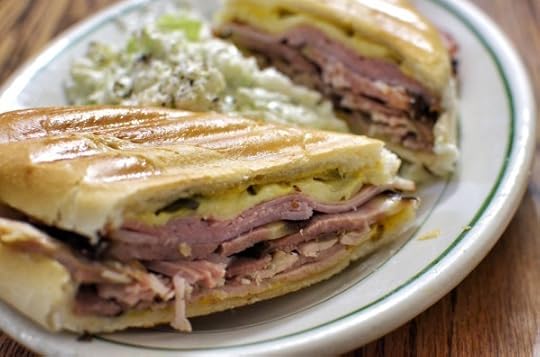
Photo: jeffreyw
The Cuban sandwich actually did not originate in Cuba — it’s from Florida. And considering it’s basically just a ham and cheese sandwich — which can be bland and boring — it’s incredible that there are no bad Cuban sandwiches, anywhere. So get hammered and try Gaspard’s Grotto in Tampa.
15. Kebab
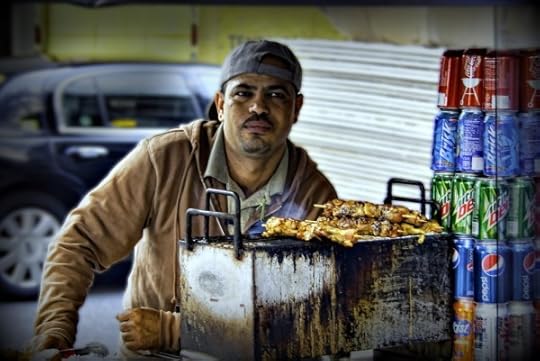
Photo: J J
Technically not an American food, yeah, but hey, neither is pizza. We absorb everything in this country. Kebabs — or, if you’re being honest about what you really want, meat-on-a-stick — are a wonderful Middle Eastern import that’s perfect for drinking. It’s usually just spiced, cooked meat, and really, what else could you want? If you’re ever in Oxford, Mississippi, check out the Chevron Food Mart for chicken-on-a-stick.
16. Bacon cheddar fries

Photo: Hannah
I mean, the beauty is in the title. Bacon. Cheddar. And fries. If you’re bearded like me, you can relish the joy of having those smells on your face for a few days afterward. You can find these almost anywhere in the US, but suggests the Lucky 7 Tavern in Jersey City.
17. Banh mi

Photo: wEnDy
While there’s a lot of horrible stuff that came out of colonialism, one of its truly wonderful products was the fusion of Southeast Asian and French cooking into modern-day Vietnamese cuisine. Americans have happily adopted two of the most popular Vietnamese meals: pho and banh mi. Pho is a soup, so it’s not well-suited to drunkenness. Banh mi, however, is a sandwich, and is perfect for absorbing the chemicals you’ve put into your stomach. There’s a large Vietnamese population in Seattle, and The New York Times suggests Saigon Deli, but they close early, so you may want to grab them after day drinking.
18. Cincinnati chili

Photo: Wally Gobetz
My hometown’s signature dish lends itself to much maligning from people who root for different sports teams, but three-ways, chili dip, or cheese coneys with Cincinnati chili on them are my #1 choice for drunk food. The best place to get it — and this is very hotly debated in Cincy — is Skyline Chili.
19. Roast beef sandwich
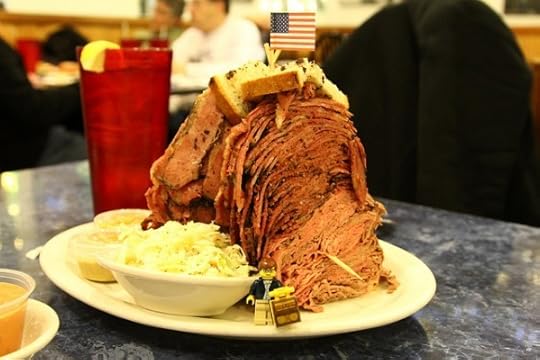
Photo: enigmabadger
Roast beef sandwiches need to be sloppy and possibly covered in cheddar. My only option growing up was Arby’s, and seriously — fuck that shit. I’m sorry, Arby’s, I need more beef than that. Residents of the great state of Massachusetts swear by Kelly’s Roast Beef as a proper drunk food.
20. Sliders
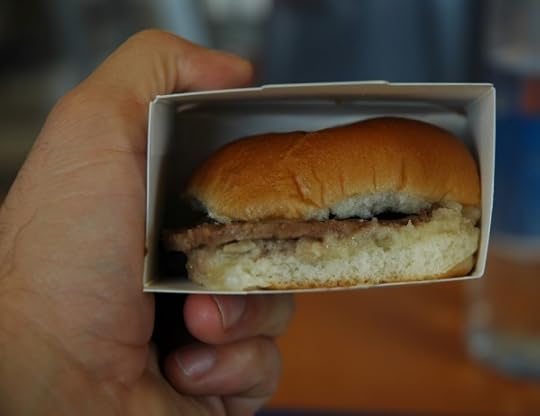
Photo: Marshall Astor
There’s no more shameful way to wake up from a night of drinking than under a pile of tiny cardboard slider sleeves. Or possibly no better. Sliders are technically hamburgers, which of course are on this list already, but they can hardly fit as much sloppiness as a regular sized burger, so really, the goal is to find one that slides easily down your gullet. My top pick? White Castle. But you should never go there unless you’re drunk or high.
21. Chicago-style hot dogs
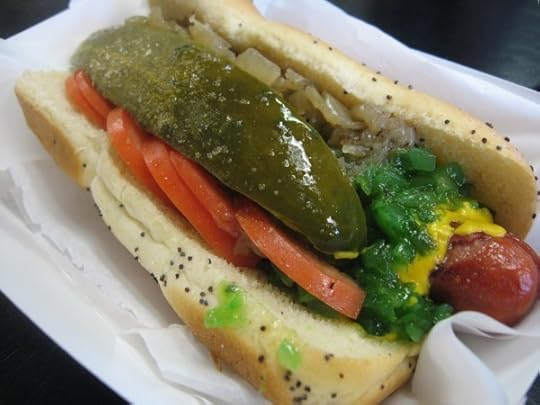
Photo: Arnold Gatilau
The beautiful thing about eating while drunk is that as long as there are a ton of flavors and a lot of grease, you really don’t give a shit about how well or clean it’s put together. This is sloppy food for slopfests. And Chicago dogs are perfect for that — you’ll wake up hungover and covered in hot dog remnants. Serious Eats gives the top Chicago dog to Gene and Jude’s.
22. The fat sandwich

Photo: Emma Story
I first met the fat sandwich while drunk at my alma mater, Penn State. They are basically subs with every nasty, greasy thing you can imagine on them: fries, chicken fingers, cheesesteak, mozzarella sticks, mayo…they don’t originate from PSU (I believe they’re from Rutgers in New Jersey originally), but these caloric atomic bombs might be the most American drunk food on here. My top place to eat them is at Are U Hungry? in State College, or RU Hungry? at Rutgers.
23. Shawarma
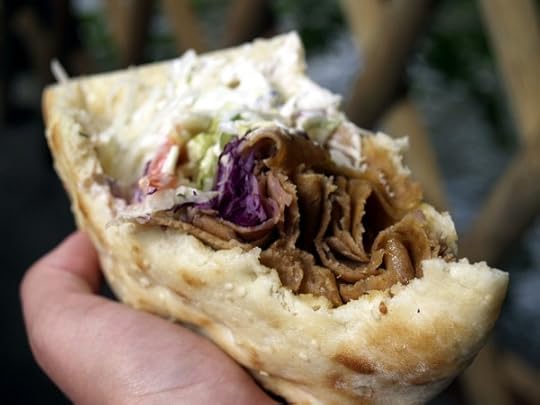
Photo: cyclonebill
You know, considering that so many Arab countries are devoutly Muslim and thus aren’t fans of drinking, it’s kind of strange that they’ve given us so many perfect drunk foods. I’m a fan of both shawarma and falafel, and the best I’ve had ever has been in the great city of London. The food thankfully got a huge boost from The Avengers movie, so if it’s not near you by now, it will be soon. I know I’ve favored DC in this article with my choices, but Amsterdam Falafel in Adams Morgan, DC is too damn good to not recommend it to everyone. 

July 10, 2014
1 card can make you a better human
ALL MY LIFE, I was told that if I made a promise to someone, the right thing to do was keep it. But while growing up, I noticed that there are so many people who make promises, and never deliver. They leave others disappointed, heartbroken, angry, or let down. It’s the worst feeling when I break a promise to someone I care about, but also when someone breaks a promise to me.
But what if we just did what we said we would do? Is it really that hard to make other people a priority in our life? Or even ourselves — if we promise to eat better, not get blackout drunk, or to call our loved ones more often? I really admire the Because I Said I Would campaign, because I think it can really make an impact on how we treat each other. Like a any type of goal, people can start small and build up to a routine. But the important thing, is to start.
If you’d like to consider donating to Because I Said I Would, you can check out their IndieGoGo campaign. If you don’t have the extra cash, you can still participate in your own personal way. 

10 worst types of Spanish men

Photo: Jiuck
1. El niñato
Smarter than the rest, funnier than most, but, ¡come on! He’s 30 and still in college. He lives at home with his parents or in a studio apartment paid for by them. His biggest aspiration is partying until the body asks for mercy. The niñato has not grown up nor does he intend to. He will come up with thousands of excuses to avoid adult life. He is an ideal candidate if you wish to stay trapped in youth, but he will become a burden if you want to share future plans, regardless of his cuteness.
2. El macarra
He is a car lover with biceps big enough to kill an elephant and seems to be a tough dude (though this is not necessarily the case). He has never touched a book in his vida, fearing he’ll get a bad rash afterwards; every Saturday night he ends up in a God-forgotten tavern with his “colleagues.” Keeping up with his foul mouth will be a challenge for any gal. He might look like a decent guy, but the macarra won’t hesitate to spend the money you’ve been saving for the holidays on flashy new tires for his car.
3. El artista
A painter, a musician, a writer…or maybe all three at once. A true dangerous type. The artist won’t stop until he’s got you mesmerized with his mysterious artistic halo and creative paranoia, helplessly in love at his feet. Yeah, he is interesting at first, but soon enough he turns into the unstable, uncertain, capricious kind. If you come across a writer who plays in a band and paints in his free time, run away as if escaping the plague. You’re standing next to a ticking bomb.
4. El futbolero
The team doesn’t matter — merengue, blaugrana, colchonero — the soccer fan will give his life for it. His team is his priority and he proudly wears the jersey or its colors at all times. He won’t miss a match (not even an amistoso), he knows the formation for every club in the Spanish League — and most of the other European ones — and he follows the trades with more passion than a gossip magazine. In his eyes, Rome is not the capital of Italy but a city in Lazio. Don’t get too attached to the soccer fan — he might sell his kidney for a World Cup ticket.
5. El indeciso
This minute it’s a “yes,” the next one it’s a “no.” Now you see me, now you don’t. I’m calling you because I can’t wait to see you, but I never make it happen. You won’t know anything about me for the next three months, and then I’ll text you “how are you” and “why haven’t you contacted me in such a long time.” The indecisive is a hell of a mess; he doesn’t know what he wants and is incapable of taking the bull by the horns. You’ll end up upside down until he gets what he wants, when he wants it. No le bailes el agua o acabarás escaldada.
6. El tuno
Endangered species, yet not extinct. The tuno is a man who goes everywhere with other members of his herd, all dressing in black and carrying musical instruments. They wander from town to town serenading women until one, by grace, excess of alcohol, or pure boredom, ends up taking a tuno home with her. In general they are likeable, but they usually end up being lame, especially after they start telling stories about the tuna. If you can get him to sing Clavelitos, you have him in your pocket. He is perfect for a surreal farce of a night, but that’s it.
7. El salsero
The salsa dancer is a particular trending type nowadays, slowly but surely invading the Spanish nightlife. He started teaching salsa with his girlfriend, but then he started changing partners in every bachata. He’s got moves, and when the latest Marc Anthony song is playing, he runs the place. He will make you feel like Dirty Dancing’s Baby, like he’ll do with the rest of us. Don’t trust the salsero, not even for a sec.
8. El guiri
Both the Spanish guy on vacation and the foreigner in Spain for a couple days fit this category. He is fun and joyful and is willing to experiment, get to know places, and have the time of his life. With him, every day is Christmas day, but ¡ojo! This is a temporal state. The minute he stops being a guiri, he will go back to his old self and you’ll end up being a holiday adventure. Any plans that you make together will flake off.
9. El desperado
Pobrecito. He just broke up with the girlfriend and he is soooo sad. All his buddies are dating and he is just dying to find a special someone (someone who can put up with him). If you give him two minutes of your life, you’ll become the most wonderful girl in the world. He tends to be pretty conservative and will suck you into his house, a wedding, and eight hijitos. The desperate guy is helpless — you or any other woman is exactly the same for him. Because what he feels is not love, but fear of being alone.
10. El fiestero
Careful, do not mistake this one with the niñato. The fiestero has a full-time job, but at work all he thinks about are the upcoming Saturday night plans. He spends long weekends somewhere with a lively nightlife, and his ideal vacation destinations are islands full of raves, all-inclusive Caribbean resorts, and Mediterranean cruises — as long as they include an open bar. Money is never a problem, if it can be spent on cocktails. 99% of the time, this specimen will evolve into a flat-out drunk. There’s always an exception that proves the rule, but if you expect your party boy to be it, you’re more inebriated than he is. 

Matador Network's Blog
- Matador Network's profile
- 6 followers



